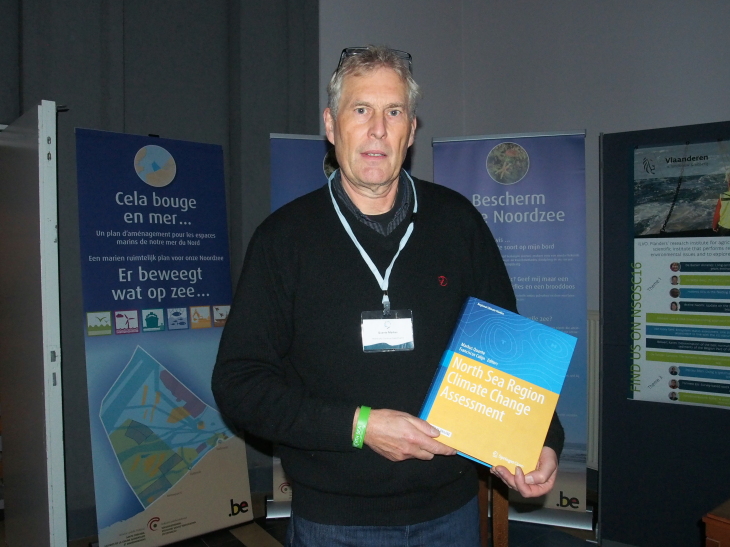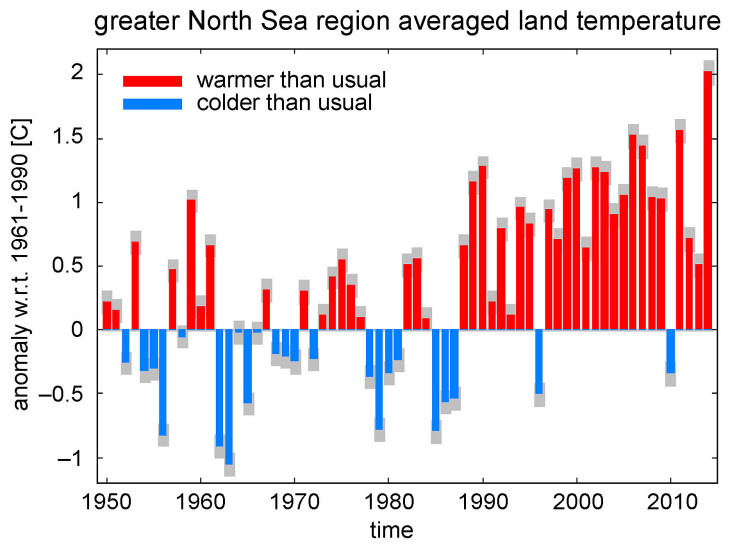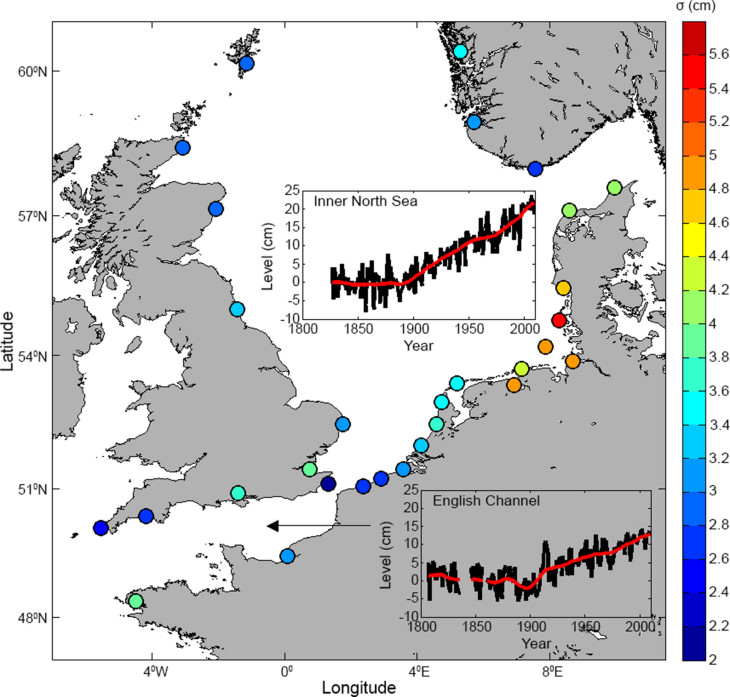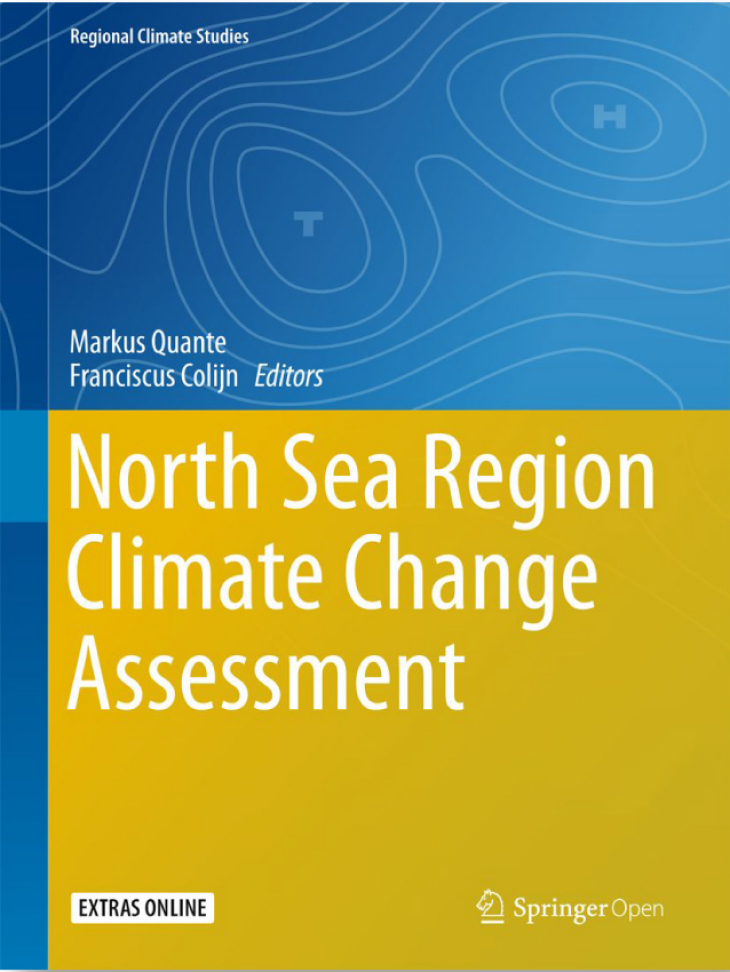Regionally noticeable change: First extensive climate report published for the North Sea Region
Like many regions in close proximity to the coasts, the entire North Sea region is affected by climate change. In the coming decades, the intensity of these effects will increase if emissions such as carbon dioxide aren’t considerably reduced. Adaptation measures require a foundation based on science. The “North Sea Region Climate Chance Assessment (NOSCCA)” report, coordinated by the Helmholtz-Zentrum Geesthacht (HZG), presents current knowledge for the first time in its entirety and shows how individual regions near the North Sea could be altered due to climate change. According to the report, scientists expect an increase in average air temperature of up to approximately 3.2 degrees Celsius in the North Sea region by the end of the century.

Prof. Dr. Markus Quante presents the new “North Sea Region Climate Chance Assessment (NOSCCA)" (Foto: RBINS / Frederic Francken)
Past measured temperatures as well as expected warming of the air in the region follows the global trend while also showing its own seasonal and annual trends. 2010 has been the warmest year on record globally to date. “The North Sea region was, however, relatively cool for that year,” says Prof Markus Quante, scientist at the Institute of Coastal Research at the Helmholtz-Zentrum Geesthacht (HZG) and coordinator of the report. In contrast to the global trend, the average annual temperature in the North Sea region was almost half of a degree below the long-term mean for the period between 1961 and 1990.

Figure 1: Average annual temperature deviation for relevant measurement stations on land in the North Sea region between 1950 and 2014 compared to the reference period 1961 to 1990. Years in blue are cooler while years in red are warmer than the reference period.
“These contrasts illustrate how important a detailed view of individual areas is for identifying and understanding regional characteristics,” Quante points out. The international research team expects an additional warming between 1.7 and 3.2 degrees Celsius in relation to the reference period 1971-2000, depending on the climate scenario used. The strongest most probable increase temporally is in winter and spatially in the region of southern Norway. One possible reason for warming is the increase of low pressure areas in the winter months, which take more northerly paths than usual and could clear the way for additional warmth from the Mediterranean.
Further sea level rise in the North Sea region is highly probable
The average sea level in the North Sea is higher today than at the beginning of the 20th century. The water rose approximately 16 to 20 centimetres in the last 100 to 120 years. The rise has been particularly noticeable since the beginning of the 20th century in the central North Sea. An additional increase in the average sea level between 30 and 100 centimetres, depending on the scenario, is highly probable by the end of this century.
Influences on North Sea Ecosystems

Figure 2: Changes in sea level at selected measuring stations in the North Sea region. Illustration of two time series for the central North Sea and the English Channel.
Climate change likely causes considerable alterations within the various North Sea region ecosystems. The distribution and occurrence of many animal and plant species are already changing. Sardines are moving farther north in the North Sea while striped red mullets and sea bass expand their habitat to the region northwest of Norway. Many lakes and water bodies in the North Sea region are highly sensitive to climatic changes. Higher temperatures shorten the periods of ice cover. Several spider, water beetle, bird and insect species—such as butterflies—will expand further into northern regions.
Comprehensive cooperation thanks to international research team
NOSCCA was initiated by the Helmholtz-Zentrum Geesthacht lead by the coordinators Prof Markus Quante and Prof Franciscus Colijn. The volume with its interdisciplinary approach is dedicated to all aspects of past, present and future climate. In addition to climate, the effects on marine and terrestrial ecosystems are also taken into consideration as well as a number of socio-economic sectors such as fisheries, agriculture, coastal protection and tourism. Altogether, approximately two hundred scientists from fourteen countries, including the Netherlands, Belgium, Great Britain and Germany, have evaluated numerous available peer-reviewed publications and data sets over the last six years. They have also compared various climate model simulations and scenarios. This up-to-date information is published by Springer in a book running approximately 530 pages. The climate report is available as a hardcover or online (open access) and was presented this week at the “North Sea Open Science Conference”, attended by approximately two hundred scientists in Oostende, Belgium.
North Sea Region Climate Change Assessment

Editors: Markus Quante, Franciscus Colijn
Publisher: Springer International Publishing
1st Edition, 2016, XLV
528 pages, 62 b/w illustrations, 215 illustrations in colour
DOI: 10.1007/978-3-319-39745-0
eBook ISBN: 978-3-319-39745-0
Hardcover ISBN: 978-3-319-39743-6
Further Information
Contact

Scientist and NOSCCA Coordinator
Tel: +49 (0)4152 87-2378
Mobil: +49 (0)170 8946325

Press and Public Relations
Tel: +49 (0)4152 87-2369
Fax: +49 (0)4152 87-1640
